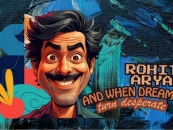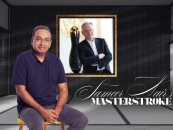-853X543.jpg)
BUSINESS: THE BIG DADDY OF THE BIG IDEA!
by Monojit Lahiri September 18 2024, 12:00 am Estimated Reading Time: 7 mins, 27 secsMonojit Lahiri takes a trip down memory lane to salute Kersey Katrak, the father of India’s creative advertising across the 1960s, 70s, and 80s. Katrak, a super creative force, seduced Lahiri—and countless others—into the most exciting profession on the planet.
Kersey Katrak’s groundbreaking approach to advertising broke traditional norms, inspiring a new generation of creative minds and ad agencies like Trikaya and Rediffusion. Known for his unconventional style, Katrak’s legacy continues to influence the advertising world.
The Maverick Who Changed My Life
Living in the shadow of a famous father is never easy, no matter the field, and advertising is no exception. For years, I wore a fatuous, moronic smile whenever my surname came up, inevitably leading to the question, “Oh, so you’re Sanat Lahiri/Sanatda/Sanat Babu’s son? Naturally, advertising is in your blood!” As proud and happy as I was—though a bit embarrassed, awkward, and inadequate too—the truth can now be told. Since I’ve left mainstream advertising and both my father and the man who led me to Adville are up there, dancing in the biggest Ad Congress of all, I can say it: no, advertising wasn’t really in my blood. And no, I didn’t come into advertising because of my famous father [ex-Lintas, Dunlop, Tata, ICI, First Asian President of the IPRA, past President of PRSI & ABC, a driving force behind the Kolkata Ad Club, and Communication Consultant to the United Nations Economic Commission for Asia & Far East]. It was because of a maverick named Kersey Katrak and an advertising agency called MCM (Mass Communication and Marketing)!
It all began in college when, by accident, a couple of ads caught my eye. It was my first introduction to Katrak and his audacious approach to advertising. Sharp, in-your-face, and unapologetically brazen, the ads dared you to ignore them, staring back at you with a bold challenge! It shook me up. In an instant, I was in my final year of English Honours at Kolkata’s St. Xavier’s College. I abandoned thoughts of journalism and zeroed in on discovering more about the freak who made those ads and his agency. I had found my Camelot!
Operation MCM: The Encounter That Changed Everything
My father, though not exactly doing the tango as he listened to my breathless excitement about those advertisements and my wild future plans, was supportive. I’m forever grateful for that. Coming from a different space, conditioned to the politically correct and conventional fare dished out by agencies like JWT, Ogilvy, and Clarion [Bates] of the 60s and 70s, Katrak’s provocative, boundary-pushing work could easily have freaked him out—but he stayed cool. It was my life, and he was there to guide, not monitor, my moves if I ever needed him. During the break between my exams and results, I took a quick orientation course at JWT to get a real taste of the industry I was dying to join. After finishing it—and loving it—I immediately headed for Mumbai: Operation MCM!
Coming from Kolkata and JWT, the MCM office at Colaba (Bakhtawar) in Mumbai and the super-hot guy running the show blew my young mind! The ad agencies back home were smart, sure, but in an old-fashioned, conventional way [“We’re here to do business, not entertain, dear boy!”]. But this? The interiors were surreal and psychedelic. Was it a pub, a disco, or an ad shop? I felt like I’d been transported to Lucy-in-the-sky-with-diamonds land. It was a life-after-death experience! Just as I was recovering from this heady ambience, a tap on my shoulder brought me face-to-face with the man himself.
Sporting jeans, a cool T-shirt, and comfy sandals, Kersey Katrak, with his trimmed beard and glowing, handsome face, didn’t look a day older than 30, though he was reportedly in his mid-thirties. After warmly greeting me, leading me to a small anteroom, and making sure my Elvis-like trembling calmed down [was this really happening?!], he did two things that made me love him—and the profession—for life. First, he clicked a button, and the window shades parted, slowly and theatrically, offering a spectacular view of the sea. While I stared zombie-like at the incredible scene, he politely asked if I’d like to join him in a Pink Gin or a Gin and Tonic. Seeing my dazed look, he assured me it wasn’t fatal, that my dad would approve, and that it was a great way to spark creativity. “Leaning on the juices and wetting the old tonsils does wonders for anyone keen on waking the dead, son!” intoned the great man. [I would come to understand the full meaning of this over time.]
After a few sips of the magic brew and some help from the Guru, I let loose. I showed him some of my published poems and articles, and offered my expert opinion on advertising and my future plans. He listened intently to this greenhorn, sometimes inviting me to recite some of my favorite poems. He confessed he loved poetry too and even wrote some “in lighter moments.” Suddenly, out of nowhere, he said, “You’re on, buddy! Join us on the first of next month. You’ll have to relocate, struggle, stay away from your family and girlfriend. You’ll receive a stipend, but your dad will need to support you. Once we see you’ve settled and flying, everything will fall into place. Just remember one thing: MCM is not an ad agency. It’s a temple and disco that worships and celebrates ideas that transform lives. Good luck!”
6.jpg)
The Legacy of Kersey Katrak
Exit Kersey Katrak. Enter the incredulous beginning of a dream, as I floated all the way to my host’s residence in Bandra, and later, all the way back to Kolkata! For various reasons, MCM didn’t work out for me, and I ended up joining JWT Kolkata, where I had the privilege of learning my craft from another towering icon, Subhas Ghosal. But that’s a story for another time. This one’s about Kersey, widely considered the father of creative advertising.
What made him so special? Why was he admired and envied in equal measure, and how did he blow my mind with just one life-transforming session? What was so inspirational about him that shaped my understanding of creativity in advertising and what a true-blue ad agency should really be? Despite never having the opportunity to work with him, the aura, achievements, and legend of Kersey Katrak in the early 70s were impossible to ignore.
Among his game-changing moves was his vision to create an environment that attracted the best talent, sending out vibes that magnetically pulled anyone who dared to dream differently. He envisioned an institution, a movement, a journey—without a safety net! (Imagine Ravi Gupta, Arun Nanda, Mohmed Khan in client servicing, and Arun Kolatkar, Kiran Nagarkar, Panna Jain, and Sudarshan Dheer all working together under one roof!). He also initiated, encouraged, and guided risk-averse individuals in both client and agency roles to break the rules—both in style and substance—if they wanted to make an impact in the stale, cluttered, and imitative advertising landscape. Long before loyalty programs, animated heroes, lifestyle advertising, and event launches became buzzwords, Kersey and his team had already been there and done that!
Fresh, provocative, reality-based advertising that brought the dead back to life was their anthem. Charismatic, articulate, daring, and flamboyant in style [he was the only ad agency CEO to zoom around in a Mercedes, throw lavish parties coveted by high society, and boast that his Delhi branch was a suite at the Oberoi!], Kersey Katrak was truly a man among men. His legacy and vision would go on to influence such celebrity agencies as Trikaya, Enterprise, and Rediffusion.
Yes, KK was my rockstar, the sexy pied piper who lured me—and many others—into the business and shaped the ad world’s earliest ideas of what advertising could and should be. He insisted, as only he could, that people who truly love this business must never be compromised; they must remember that they haven’t forfeited their right to dream, nor lost the ability to reimagine and reshape the world as they believe it should be.
That was Kersey Katrak—the inspirational samurai, the glamorous gladiator forever seducing the edgy, freaky, quirky, and courageous to abandon their Jurassic notions and take that leap of faith to touch heights sublime.
In 2024, this all feels like another lifetime. Kersey passed away in 2007. When will we see another like him...





-173X130.jpg)

-173X130.jpg)
-173X130.jpg)


